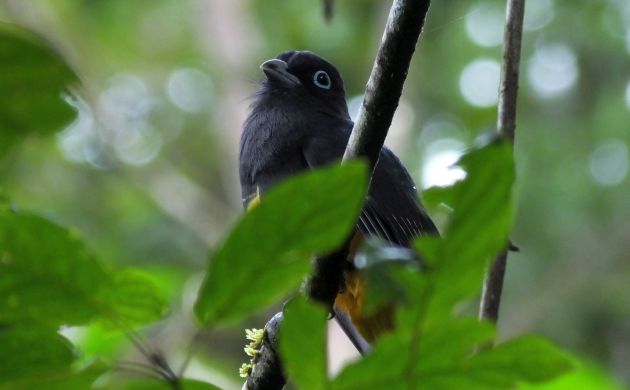
I have a confession to make. Last weekend, I went on a birding binge. I spent two full days where the birding was near constant, and, just to keep the binoculars from being neglected, topped it off with another half day of birding on our drive back from Cano Negro, Costa Rica. I confess to giving myself over to nature observation but I make no excuses- a birding binge is always good (except I guess if it makes you lose your job, partner, or life). But since an official counting of birds on Saturday was part of the binge, hey, we had to do it anyways! That was the day of the second ever Cano Negro Bird Count and what a birdy time it was!
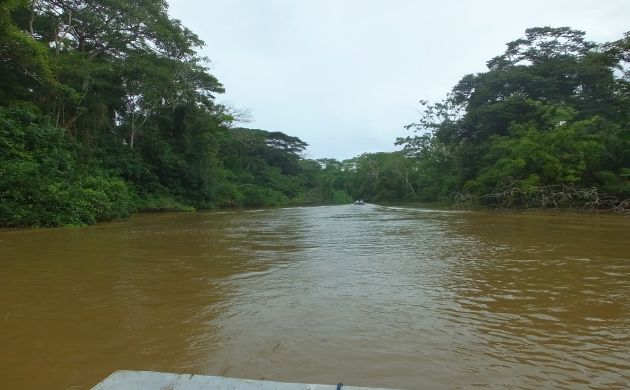
Most of the counting was done from boats.
While sitting at my computer and giving this past weekend a mental going over, I wasn’t even sure what to call this post. “Bird Count at Cano Negro” was too mundane to portray the boat rides, mosquitoes, remote habitats, the surprise lamb chops lunch, and other situations. I almost called this here thing, “Birds, Tragedy, and Hope at the Cano Negro Bird Count” before common sense prevailed and cancelled out the drama. In any case, to see why I almost chose those titles but settled on “Birdmania”, just keep reading.
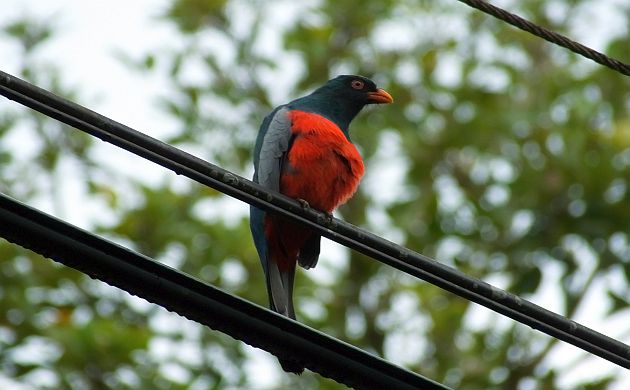
Trogons like this Slaty-tailed should always play a role during a birdmanic weekend.
Like most of my birding weekends, this one began somewhere in the Central Valley. That’s where most of Costa Rica’s population resides and because of that, it’s also why we headed out around dawn, happily leaving the long line of vehicles on their way to San Jose in the rear view mirror. The bird counting begins as we drive to greener spaces and on this weekend, thanks to Chris Wood of the Cornell Lab. of Ornithology being in our vehicle, eBird lists were a constant. One of our first was at the remnant marshes of El Silencio, a small site just off the San Ramon-la Fortuna road that is always worth checking. Although we added a few birds for the binge birding weekend, nothing rare showed so we moved on shortly after arriving to look for tanagers, mixed flocks, and anything with feathers at the San Luis Canopy and Manuel Brenes Road.
San Luis was surprisingly slow but thanks to our early start and cloudy weather (because it boost bird activity), we picked up the decidedly uncommon Lattice-tailed Trogon, several tanagers, and other birds in the foothill rainforests on the Manuel Brenes Road. After lunch in La Fortuna, we raced north on good roads, then slowed down on a rougher road that leads to Cano Negro. Along that stretch, we enjoyed Fork-tailed Flycatchers and other species in the open fields and marshes including Harriss’s Hawk, the local Nicaraguan Seed-Finch, and, best of all, a pair of normally sneaky and secretive Yellow-breasted Crakes walking in the open through a grassy marsh! They were still doing the creeping rail walk but at least it was in plain sight.
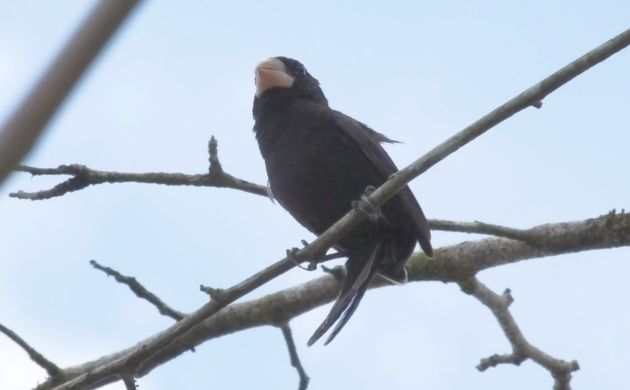
Nicaraguan Seed-Finch
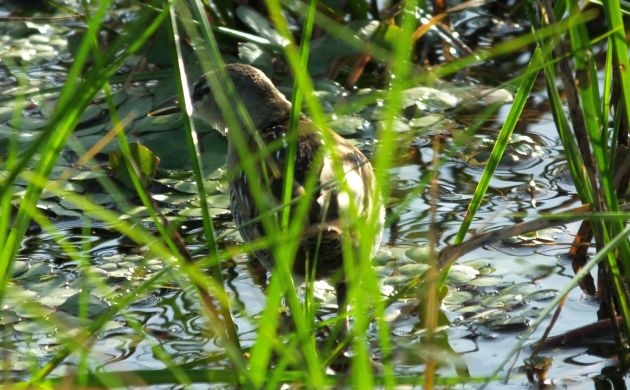
A creeping Yellow-breasted Crake from another day.
In the evening, we met up for the official count meeting and as with other bird counts in Costa Rica, this one was well organized and a semi-event that included coffee, some pastries, a count tee-shirt (showing a creeping Yellow-breasted Crake!), and presentations given by the organizers about the importance of the count, routes, what to look for, and so on. Fellow bird counters introduced themselves and it was wonderful to see a few people who were totally new to birding in such a birdy place. My biggest kudos go to the young woman who had taken several buses to reach Cano Negro from San Jose without really knowing what she was getting into! By the end of the count, I think she was hooked, I hope so.
After the meeting, we passed on looking for potoos and owls (Cano Negro is an excellent area for that) so we could get plenty of sleep in the comfortable Hotel de Campo. I know, what kind of birding binge pays any attention to sleep? I suppose one where the players have more than forty years under their belts although the 3:45 in the morning alarm still kept us on our birding toes. A pre-dawn start was necessary to leave from the dock with enough time to reach our counting areas by five. This was especially true for our team since we were headed to one of more remote parts of the refuge, the “Finca Terrion”. Count organizer Renato Paniagua had told us about the place nearly a year before during the Arenal Christmas Count, captivating us with tales of Jaguars, the rare and wilderness needing White-lipped Peccary, and the tantalizing fact that the forest had never been surveyed for birds. It’s actually an easy place to find on a map of Cano Negro. Just look for the biggest, darkest green spot and that’s the farm, the last sizeable remnant of intact rainforest in the area.
We were headed there but the meeting with the wild area would be bittersweet. We already knew that, Renato had told us how Hurricane Otto had felled much of the forest the night before. With that tragic news went any hopes of finding something like a Crested Eagle or Great Jacamar but it would still be exciting to visit. What still lived there? What might persist in a hurricane damaged forest that was already growing back?
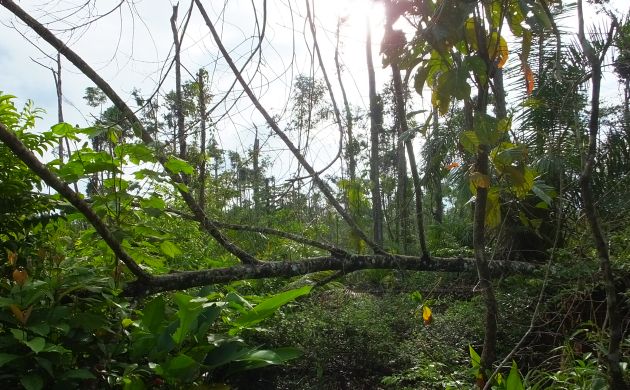
The damaged forest.
We would find out shortly after arriving at the farm but first we had to traverse muddy pastures with hedgerows where Red-eyed Vireos and Summer Tanagers fed. It was counting time and hard to keep up with many expected edge species while occasional forest species punctuated the humid morning air with their calls. One of those species was a Pied Puffbird, our sole individual for the day and maybe the only one for the count. White-ringed Flycatchers also sang as we approached the forest, a kiskadee-like bird that lives in the canopy. A female Snowy Cotinga, another canopy species, surprised us by swooping down low to feed on fruits at eye level while a Bat Falcon had breakfast on a snag, and a Wilson’s Snipe, a great find, burst into view from underfoot. Various species of parrots and parakeets flew overhead and the birds kept coming even when we entered the forest.
Around 500 meters from the farm house, we reached the forest. Renato and the owner of the farm had cut a small trail into it and had warned us about the mosquitoes. They weren’t joking. When a hurricane smashes a rainforest, it apparently doesn’t just knock down too many trees. It also creates some mighty fine conditions for minute blood sucking freaks, ones so voracious that they apparently become immune to DEET. We got bit but we also got birds. Northern Barred and Wedge-billed Woodcreepers, Bicolored and Chestnut-backed Antbirds, Dot-winged Antwrens, and other forest species unlikely to be found elsewhere during the count. A fair-sized mixed flock gave us more birds, nothing rare, but it was still good to see that birds were surviving in the post hurricane habitat.
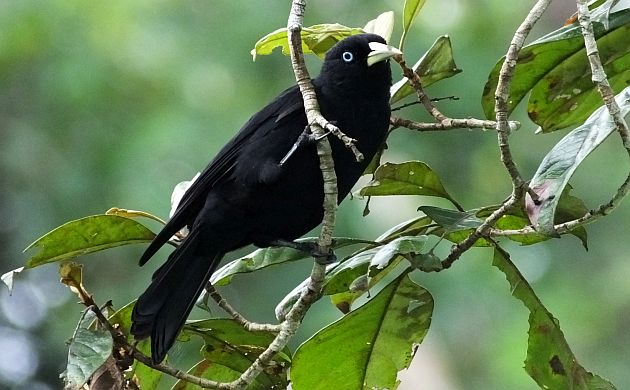
We also had close looks at Scarlet-rumped Cacique.
Heading back to the farm house, the counting continued and more species made it onto our list; four Green Ibises that hissed at us while feeding at the base of a massive tree (seriously, they hissed!), surprise White-fronted Parrots that fed in a fruiting tree, flycatchers and other species including excellent close looks at an uncommon Yellow-bellied Tyrannulet. Rain came and went but it cooled things down and also gave us a chance to sit down and enjoy a wonderful, home-cooked meal of rice, beans, and lamb! A delicious surprise and lunch made all the more memorable by the presence of tropical birds, good company, and a wild “pet” tarantula.
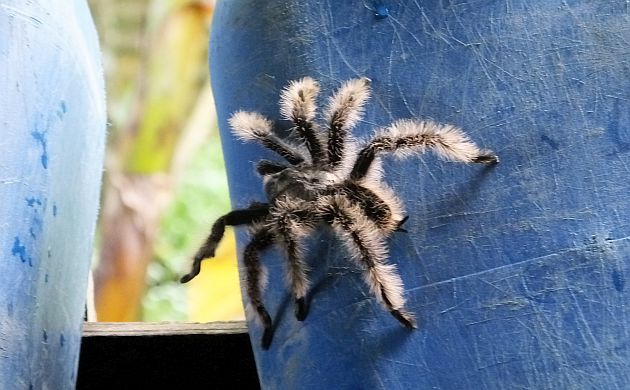
The owner of the farm has let this tarantula live to a fine, old age.
After a warning about crocodiles, we checked the river and picked up a few more birds but nothing rare. More interesting was a troop of Spider Monkeys that ranged through the canopy of old growth trees, around eight total that shook the branches with swings on long grasping arms and tails. Eventually, it was time to head back upstream and we counted more birds, an Osprey here, a group of migrating raptors there with a late Mississippi Kite, Swainson’s Hawks, and a couple other birds. A flyby Giant Cowbird, herons that squawked as they lumbered off on broad, dino-wings. Orioles in the tree-tops, the occasional Prothonotary Warbler flitting at the edge of the river. Near the refuge headquarters, Renato also showed us the new observation tower.
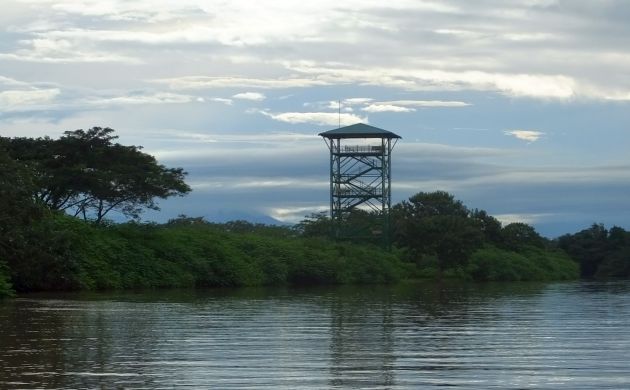
Big, sturdy, and a fine place to watch for raptors, Jabirus, and many other birds of Cano Negro.
Then, before we knew it, the bird count was over. Time flies when you are putting the focus on birds but especially when there are nearly too many to count! That’s how Cano Negro is, one of the most important wetland areas in Costa Rica and one that also includes bonus birds of lowland rainforest. At the count dinner (another semi-event that included a delicious supper, music, and a tally of the day’s results), we found that most of the specialties of the refuge had been recorded (including the creeping little crake), that our team identified nearly 150 species, and that the team with the most almost found 160 species of birds. Some regular things were also missed, probably because of rain and lack of coverage in the village, especially night birds, but it was nevertheless one heck of a birdy day! Many thanks to Renato Paniagua, Tatiana, Juan Diego Vargas, forest rangers at Cano Negro, and the local community for making it happen!
Of course the birding didn’t stop on Saturday, though. We still had to drive back on Sunday and since that involved a morning at Hotel de Campo and passage through some very birdy marshes, well, we just had to keep birding. More forest species were seen in the hotel gardens including Cinnamon and Rufous-winged Woodpeckers, tanagers, and other species.
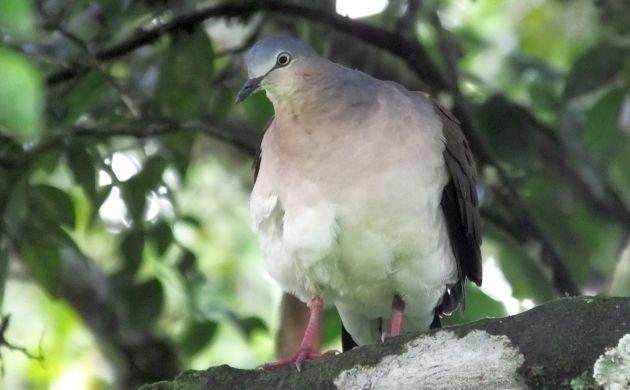
We also had close looks at the local for Costa Rica Gray-chested Dove.
Our final pass through the marshes presented us with large flocks of herons, egrets, and other waterbirds including a duo of excellent Long-billed Dowitchers, singing Nicaraguan Grackles, and one or two other trip species. Beyond there, the drive mostly goes through orange orchards and other cultivations, places with few birds. That didn’t stop us from looking but we didn’t see anything new and our birdmania weekend pretty much came to a close. However, it was a good ending, one with several year birds, lifers for several, more than twenty species of raptors, four species of trogons including the Black-headed Trogon at the top of this post, and over 250 species identified in less than three days. Already looking forward to my next days of Birdmania!












Man, I need to get back to Costa Rica!
Though you can keep the mosquitoes.